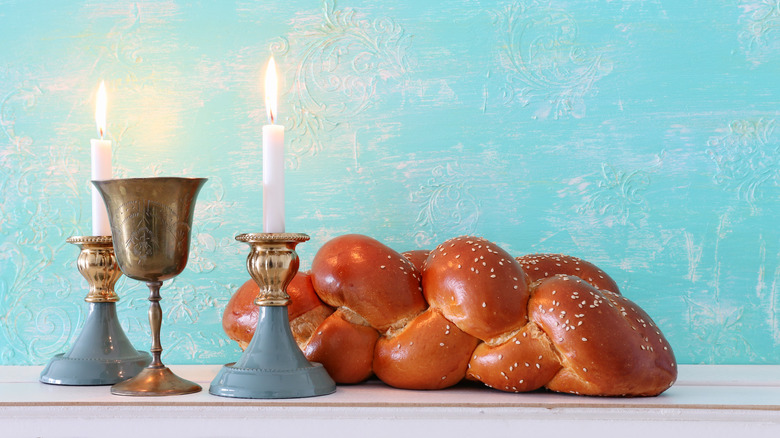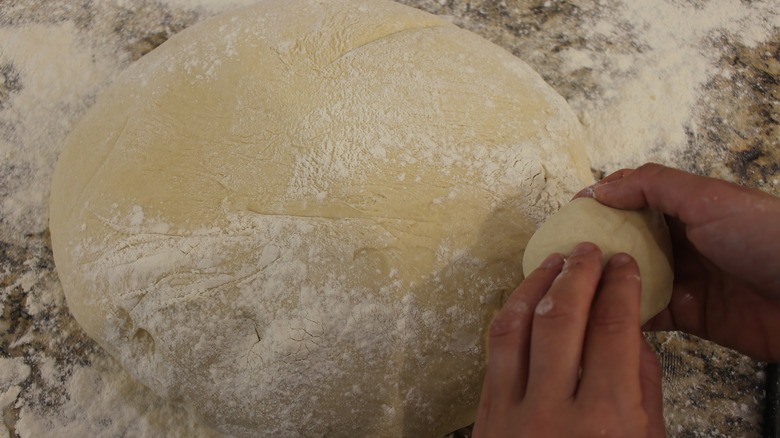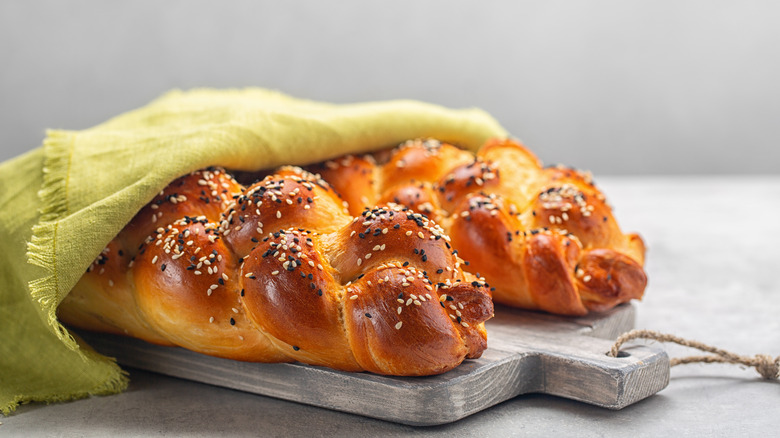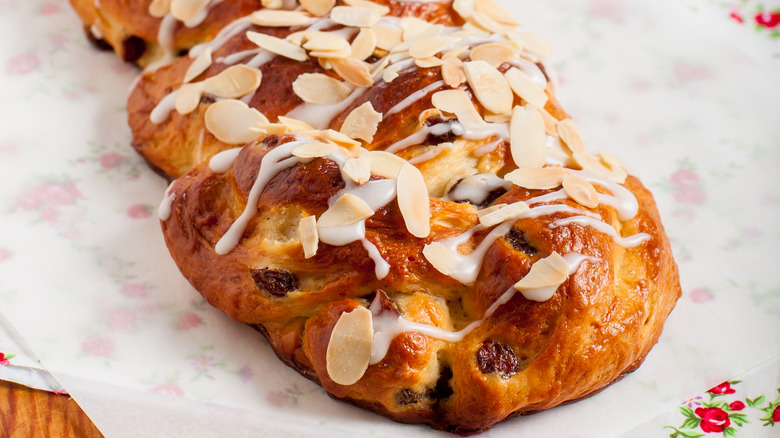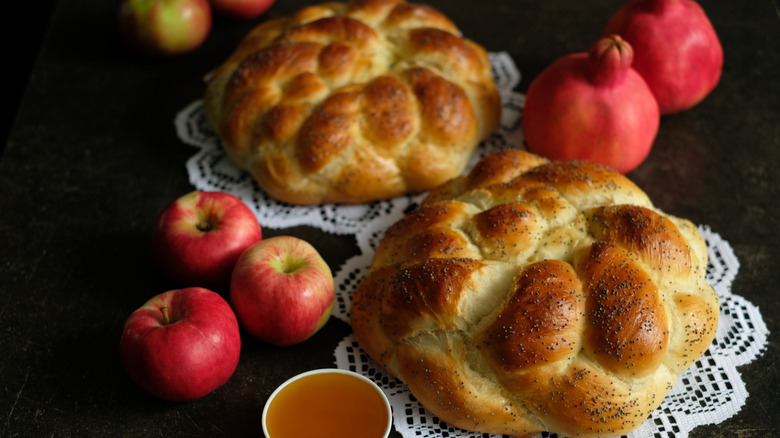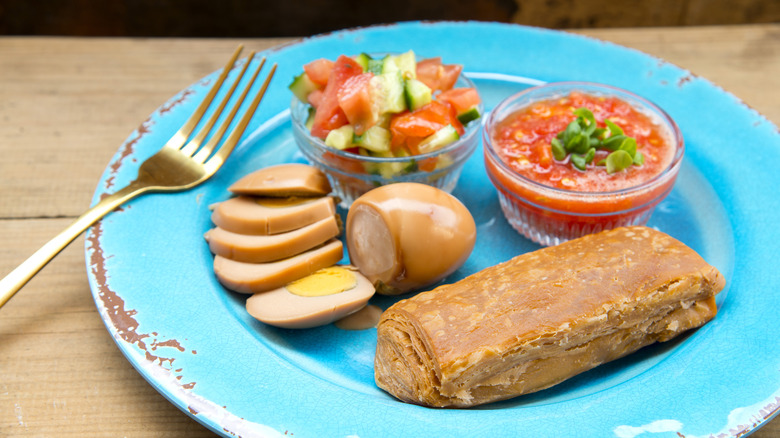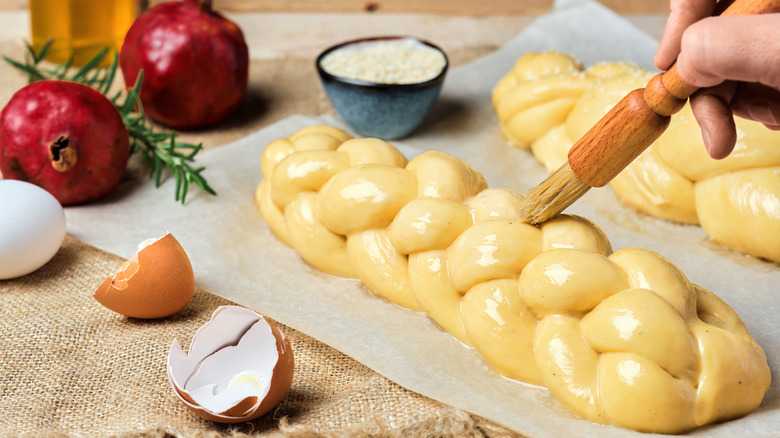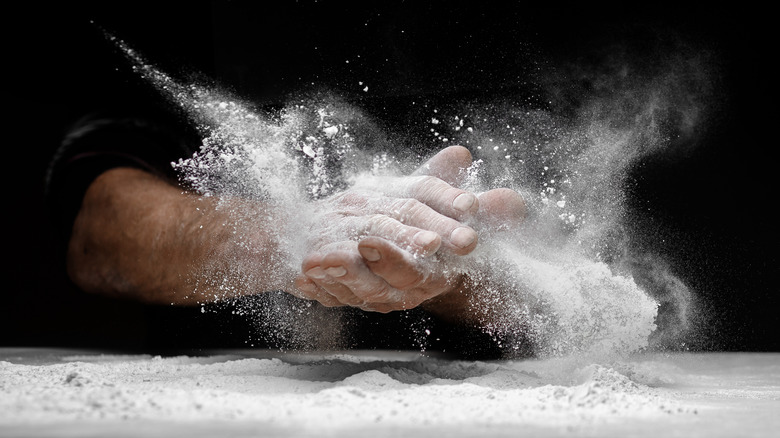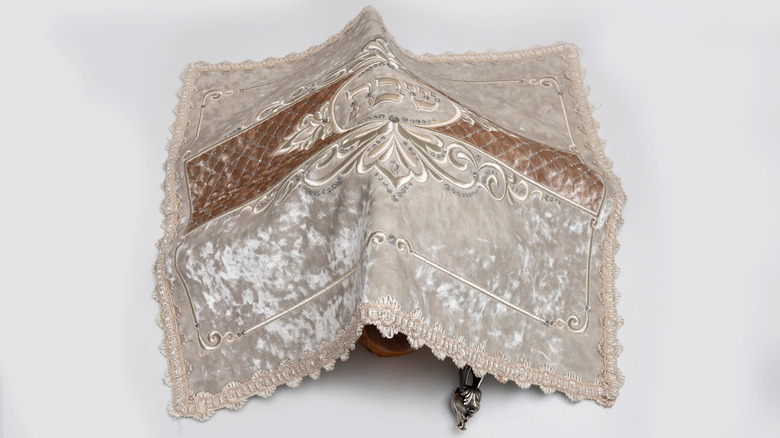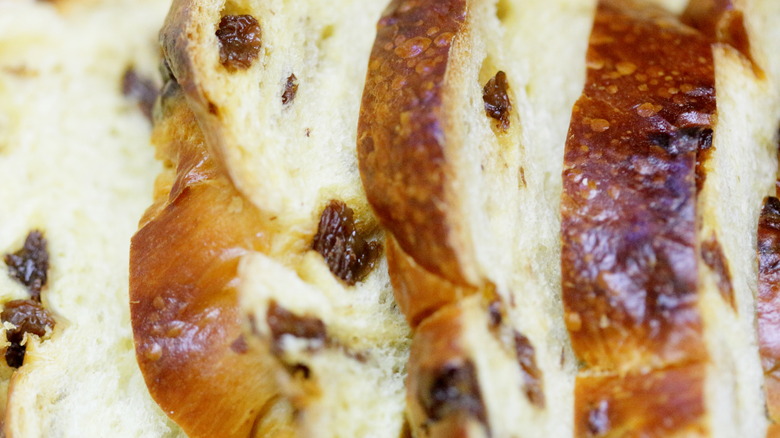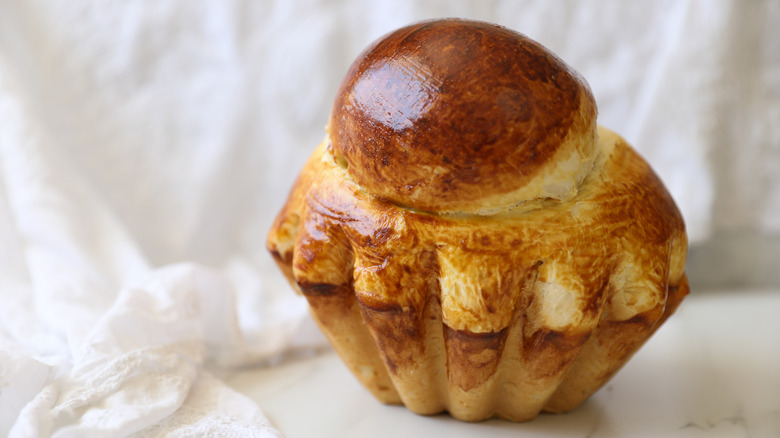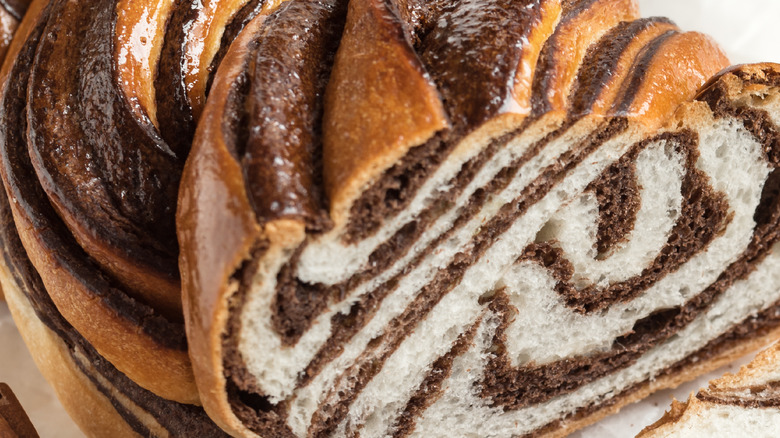The Untold Truth Of Challah
Challah is a highly symbolic bread, with everything from the individual ingredients to the number of strands used to form the loaf functioning as a spiritual symbol. It's also a popular bread to bake and eat, regardless of what religion or spiritual practices you observe. Challah's journey from special ritual bread to widely eaten loaf spans centuries and cultures.
The challah most people in the U.S. are familiar with is the soft, puffy egg loaf that's part of Ashkenazi Jewish cuisine. It's the bread eaten with Sabbath meals, but that's not the only type available. Ashkenazi (Central and Eastern European) and Sephardic (descended from Jews expelled from the Iberian Peninsula during the Inquisition) Jewish communities developed their own versions of the loaf, with Sephardic versions containing spices like coriander and saffron, as well as rose water, nuts, and olive oil (via the New York Times). This doesn't even take into account the many Sabbath breads that aren't challah that are used in Jewish communities around the world. The untold truth of challah is that of bread that has retained its ritual use, even as it became a fixture of bakeries and cookbooks.
'Challah' refers to two different parts of the loaf
For most people, challah refers to a loaf of sweet egg bread. However, in Jewish tradition, it also refers to a piece taken off of the unbaked dough that is later cooked separately until it is burnt. The original use of the word "challah" was for 1/24 of the dough, which was originally given to temple priests, although it later evolved into a small portion of dough that was burnt in one's home oven, according to My Jewish Learning.
"Challah" was not used for the rest of the loaf until the 1400s in central Europe, when cooks started using white flour to create larger loaves of bread for Sabbath meals. Before the 1400s, Sabbath breads were typically flatbreads. A rabbinical student named Rav Yosef ben Moshe recorded his teacher's Sabbath habits, noting that his teacher would have 3 loaves of challah (via Kosher.com). Even then, the use of the name "challah" didn't take off; these white-flour Sabbath loaves were often called different names in different communities, including "lachamim," "kitke," and "barches." A name used in the 1600s in Poland was "khale." This, plus other similar names, gradually gave way to "challah" in the United States at the beginning of the 20th century.
For a Sabbath meal, get 2 loaves and don't forget the salt
Shabbat meals require 2 loaves of challah. As with other aspects of challah, this number is spiritually significant; in the story of the Exodus from Egypt, in which the Israelites wandered for 40 years through the desert, twice as much manna would fall on Fridays compared to other days of the week. This was to ensure the Israelites would have manna on Saturday, or the Sabbath, according to Modernist Bread. The 2 loaves are the modern symbol for that 2-day supply of manna.
The challah pieces should also be dipped in salt, partly for flavor and partly to represent the relationship between you and God. There is a verse in the Talmud that compares a table with food on it to an altar with offerings, and these "offerings" of food must contain salt, according to the verse. The Kabbalah considers challah to be a symbol of kindness and salt a symbol of "divine severity," so the challah is dipped into the salt to symbolically place kindness above that severity, and not the other way around, per Chabad.org.
On the non-spiritual side of things, salt is a vital ingredient in challah if you want it to taste good. Chef Alex Guarnaschelli says that if you forget to add salt to your challah dough, eat toasted slices with salt and butter or gradually add salt to the food around it.
Challah varieties have increased greatly since the 20th century
The loaf of somewhat sweet bread, maybe with raisins, was the most well-known form of challah in the United States until about the latter half of the 20th century. After that point, people started experimenting, adding fillings and making savory challahs — not necessarily Sephardic challahs with seasonings like sesame, but loaves of the Ashkenazi-style egg bread with add-ins like cheese, pastrami, chimichurri, and dill, according to My Jewish Learning. You'll also find just about every sweet variation of challah, too, stuffed with chocolate chips, jam, apple chunks, and even enough fruits and nuts to make a combination of fruitcake and challah.
Fusion challahs have also become popular, including Molly Yeh's scallion pancake challah (per My Jewish Learning), as well as challah turned purple with ube powder, per Abby Cooks Dinner. Then, there are the challahs that are pure fun; in 2021, Duff Goldman of Charm City Cakes and "Ace of Cakes" posted a picture of sparkly challah sent to him by the Jewish Food Society.
Both braided and round challah have specific uses
If you buy challah from stores, you might have seen braided loaves most of the year, and then round loaves appearing in September and October. This is because the round loaves are specially made for Rosh Hashanah, the Jewish New Year. Challah is often baked in special shapes for specific holidays, with round Rosh Hashanah challah representing the cycle of the year, the crown of God, and prayers for a blessed year ahead.
Depending on the holiday and the community, you can find challah baked into even more shapes. Some are animal shapes, such as swans and birds, according to NPR. Jamie Geller explains that for the first Sabbath after Passover, the challah is supposed to be in the shape of a key, called "schlissel challah," which represents the end of falling manna and the beginning of the Israelites' reliance on themselves to find food during the 40 years of wandering the desert. Challah baked around Yom Kippur is often in the shape of a ladder, which is a symbol for either sending prayers up to God or for how God is in control of our lives, according to Ritual Well.
Some Jewish communities have their own Sabbath breads
While Ashkenazi and Sephardic Sabbath bread tends to be a soft, braided loaf of challah, other Jewish communities historically did not use challah for Sabbath meals. These communities either had their own special Sabbath bread or used whatever bread product was part of their daily diet. For example, Yemenite Jews have kubaneh and jachnun, typically eaten on Saturday mornings after services at a synagogue, according to Tablet Magazine. Ethiopian Jews have dabo, which is often a dense, spiced, unbraided loaf but can also be a plain egg bread, according to Jewish Women's Archive and Jewish Food Society. Writing for "The Forward" about Indian Jewish communities, Shulie Madnick explains that most of the Jewish families in Mumbai use Indian chapati and puri as Sabbath breads, while Baghdadi Jews — another Indian Jewish community — were known to eat khibis, an Iraqi flatbread.
This often changes when members of these communities move to Israel, with challah taking its place at Sabbath tables, even if the rest of the meal is Indian, Ethiopian, or from another community. Madnick notes that blessing challah instead of another bread is becoming a little more common in Indian Jewish communities in Mumbai.
Interestingly, jachnun may have been introduced to Yemen by Spanish Jews seeking a place to live after being expelled from Spain. According to writer Liz Steinberg, both jachnun and malawach may be descendants of the puff pastry made in Spain at the time.
Think good thoughts when you make challah
The ingredients in challah represent blessings, and the idea is that when someone eats the challah, they are taking in those blessings. In an article for Ohel Sara, writer Yiskah Fantl says that each step in baking challah gives the baker a chance to mull over their life and ask for blessings to be added along with ingredients. When adding water, for example, she says one should concentrate on a happy home, and that water represents "chesed," or kindness. Adding oil to the dough is a time to pray for a more open mind and softer effects from the words and actions one speaks and does. Mixing and kneading are times to contemplate oneness and pray for peace and unity.
Even the act of braiding a typical loaf of challah is infused with symbolism. Jewish Boston says the braiding represents the combining of one's secular life with one's Sabbath life, in addition to the transition one makes between the two. The number of strands or braided sections also has meaning, with specific numbers matched to imagery, such as 12 strands representing the 12 tribes of Israel, or 6 strands representing each non-Sabbath day of the week, per My Jewish Learning.
Why fine white flour is used in challah
When the challah loaves we know today were first baked in central Europe, typical everyday bread was "black," or rye, according to Aish.com and Shipton Mill, respectively. Because the cooks wanted to show that the challah was special, they used finer white flour. In fact, Moment Magazine says the idea of being able to eat a soft loaf of challah every day was used as a poetic representation of the American dream for European Jews.
White flour used to be a product that only the upper classes could access easily, mainly due to the extra effort that had to go into producing it, according to Bob's Red Mill. As technology advanced in the late 1800s and early 1900s, the production of white flour became easier, and the final product was thus more affordable. People preferred the softer grain that wasn't as tough on the digestive system as whole wheat flour could be, and by the mid-20th century, white bread had become the preferred choice, according to Rachel Laudan. However, challah remained a special bread because of its link to Sabbath meals.
Sabbath challah is treated as if it has feelings
Blessings are said over the food and drink served during a Sabbath meal, including the challah, which remains covered with a special cloth until a specific blessing for challah is recited. This is supposed to protect the challah's feelings, which sounds very strange at first because you wouldn't think inanimate objects are particularly emotional. It's not that Judaism actually considered challah to be sentient — instead, this is supposed to be a lesson in kindness.
Blessings over Sabbath meal foods have to be said in a specific order. According to Chabad.org, challah should be the most important because it represents the manna that fell during the Israelites' 40-year journey through the desert after leaving Egypt. However, blessings are first said over wine. The cover is required because it acts as protection to ensure the challah isn't insulted or made to feel bad about not being blessed first. My Jewish Learning notes that Judaism emphasizes acts of "loving-kindness." The idea of not hurting the challah's "feelings" is meant to be a reminder to those around the table to be kinder to other people.
It's not known why raisins ended up being a fixture
Challah was traditionally not very sweet, but it became much sweeter once Jewish communities in the United States started using more sugar — it was easier to find and afford in the United States. However, sugar isn't the only sweet ingredient in basic challah. A classic variation for Ashkenazi-style challah adds raisins to the otherwise plain dough. How they got there in the first place — or when they got there — is not known for certain.
The Nosher says it may have been due to bakers using leftover babka dough that contained raisins to make challah. Older styles of babka were drier and did not contain ingredients like butter, so the dough would have been suitable for challah, per Food52. It is certain that raisins have been added for many years, as evidenced by the existence of family recipes for raisin challah that has been used by generations of family members.
Challah is soft and sweet like brioche
Challah's sweetness and softness are reminiscent of brioche, but you would not use brioche dough to make challah. You can make a challah-like loaf with the dough. However, the use of butter — a dairy ingredient — in brioche dough means that loaf wouldn't be appropriate for a kosher meal that includes meat. Kosher dietary laws require preparing and eating dairy and meat separately; they can't be at the same meal or prepared with the same utensils and in the same pans, per Chabad.org. Instead, you have to take certain steps to make the utensils usable for one or the other, according to Chabad.org. Challah's lack of butter means it is "pareve" or "parve," which is a category of food that you can eat with either dairy or meat meals. Brioche with butter in it would automatically not count as challah.
The increase in kosher vegan products brings up the question of whether something made with vegan dairy substitutes would be considered pareve. The Orthodox Union, one of the organizations that handles kosher food certification, says that in general, kosher vegan items are considered pareve. They don't address whether brioche created with vegan dairy substitutes would be pareve and could be used in place of traditional challah.
Babkallah – need we say more?
Given that people are experimenting with challah left and right, it was only natural that someone combined babka and challah. Bon Appétit's creation uses mainly babka ingredients but plaits the strands of dough like challah. It also omits the streusel topping that so many babka recipes call for. The author and creator, Claire Saffitz, writes that the braiding process is easier than the twisting process used for babka, and it allows you to bake the pastry without needing a loaf pan. Like challah, you can turn slices of leftover babkallah into French toast the next day.
The only caveats are that the ingredients — especially the chocolate — need to be of good quality, and that the recipe contains milk and butter. That means you can't eat babkallah with a kosher meat meal if you're observant. Obviously, this won't matter if you're not kosher, but keep it in mind if you're bringing a baked good to someone who does keep kosher.
